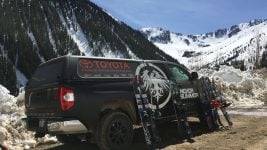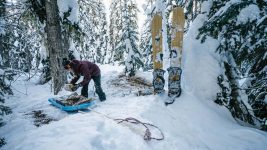
Spark 21/22 Splitboard Hardgoods Preview
Retail Buyers Guide: Splitboard Hardgoods 21/22 Retail Buyer’s Guide
Brand: Spark R&D
Interviewee: Dan Ventura, Marketing Manager
Please provide an overview of how 2021/22 is shaping up for your brand. Has COVID-19 affected your line? If so, please explain the changes you’ve made, and how you came to these decisions.
This year has been crazy for Spark R&D and really all backcountry brands. Demand for our current line is pretty wild. COVID-19 has certainly affected our current timeline and will impact how we plan for 21/22. Right now, COVID simply put us behind production-wise as we had to shut down the operation for a full month in the spring of 2020. Beyond that fully lost month, we went through the heart of our production season with social distancing and other safety precautions in place that while completely worth it and necessary, are not efficient for manufacturing.
This is impacting our thinking on 21/22 in a couple of ways. For one, testing and prototyping came to a screeching halt last spring. Late season is a great time to splitboard and is crucial for our product testing timeline – long days and more stable conditions are ideal for putting our gear through the wringer. Products and upgrades that had good potential for the 21/22 line just didn’t get as much time on snow and with our gear testers as we’d like. Secondly, because production went long, we just didn’t have as much time as we’d like to critically discuss changes for the next season. We had to stay focused on delivering for our retail partners and all the splitboarders out there.
How much of your new line (pre-COVID) is normally dedicated to new models and artwork, and how has this changed, percentage-wise, for 21/22?
Very little of our line, at least in recent seasons, is dedicated to new models and artwork. We are a tech-driven company and our T1 Tech has been the industry-standard for multiple seasons now. There will be subtle changes to our Arc, Surge, and Pro bindings in 21/22 but that has more to do with how dialed the system is and less to do with COVID-related delays or plans.

Arc Bindings
If you will be carrying over a larger proportion of your products than normal, how do you hope this will be received by retailers?
We will be carrying over a large portion of our line and we think our dealers will be stoked. Our gear is selling extremely well this season. Not shaking things up too much seems wise and is one less thing for our dealers to worry about. That said, we’ve got some cool ideas and changes in the pipeline.
If you’re pressing ahead with new items, what are the top three most important products of next year’s line, and why? Please refer specifically to new products here, and not just new marketing stories.
Right now, no. We’ve got big things in the works, but we’re really looking at the 22/23 line for that. We’re focused on finishing this season strong and going into 21/22 on solid ground.
Any big advancements in functionality? Skinning, transitions, etc, as well as riding?
No. Our gear is known for being extremely reliable and functional. We’re going to stay the course for now.
Prices: Which area of the market do you primarily cater to, price-wise? Has this changed at all in recent times, or is it pretty consistent?
Our bread and butter will always be with our standard line of T1 bindings – the Arc and Surge. They represent the middle price point binding in our line and in the greater splitboard binding category. They are stylish, ultra-functional, and still affordable. They’ve really hit a nice balance price-wise for our retailers and likewise, the end consumer. It’s also worth noting anytime we talk about Spark price points that regardless of international tariffs and trade uncertainty we’ve been able to offer our T1 line at a consistent price since their debut in 2014.
Beyond our standard line of bindings, we have a lower price point economical model in the Blaze and have options for the higher price point consumer who want the best of the best in our Pro line.
Please tell us about the dominant visual themes in your 21/22 gear, including any interesting artist collabs you have lined up.
Speaking honestly, as of the fall of 2020, we haven’t one hundred percent decided. We’re not feeling a lot of pressure from splitboarders or dealers to make any huge changes given the current environment. Anything we do on the visual front will be subtle and similar to what we’ve done the past few seasons.
Most brands tell us that selling in-store is really important for splitboard gear, as it’s where you can get good advice. Can this be maintained post-COVID, or will you be looking to find more customers online?
Good question. Selling in our brick and mortar stores will always provide a couple of key advantages for our splitboard gear and splitboard equipment in general. I think the advice you mention applies to both the actual equipment and avalanche safety and education component. In-person, conversations are helpful for consumers to ask good questions and get immediate answers. Shop employees are also in an excellent position to begin observing their customer’s level of understanding about backcountry travel and perhaps recommending some important next steps education-wise to go along with their gear purchase.

That said, we’re currently seeing a strong brick and mortar sales. So yes, we believe the brick and mortar game for snowboard and splitboard gear will remain strong in the future.
What are your three biggest European markets for splitboard hardware?
In terms of dealer density, Switzerland. If we’re talking volume, it’s mostly packed into Switzerland, Austria, Germany, and France.

























